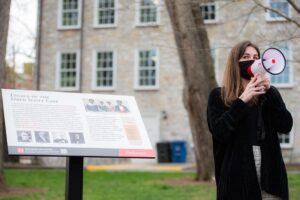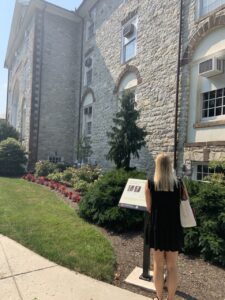
Me explaining the Dred Scott wayside marker (Carlisle Sentinel)
On April 7, I was involved in the launch of the House Divided Project’s new Dickinson & Slavery Historic Walking Tour, a tour designed to be a self-guided learning excursion highlighting people and places that are of historical significance to the college. This launch event was the first formal in-person ceremony that the college had hosted since the beginning of the pandemic, and attendance revealed that. Members of the community, faculty, students and even prospective students turned out. The event began with a speech from former President Margee Ensign who spoke briefly about the House Divided Project, specifically its Dickinson & Slavery initiative. She discussed how its work is helping to create a more equitable and just society, ending with “the time is always right to do right.” Then we began the tour, which consisted of six different stops. The wayside markers at each stop explain some aspect of how slavery is rooted in the college’s history. There are markers explaining the contradictory views of college founders Benjamin Rush and John Dickinson and the involvement of local slaves in constructing campus buildings. One marker highlights the ties both supporters and opponents of the controversial Dred Scott decision had to Dickinson, and others discuss popular 19th century black figures who worked on campus as food-sellers, janitors, policemen, etc. that have not been previously recognized. Also included in the tour is a stop at the House Divided Studio and soon-to-be Spradley-Young Hall, named after Henry W. Spradley and Robert C. Young who were two of those popular figures. Their names will be replacing Cooper Hall whose namesake, Thomas Cooper, only worked at Dickinson for a few years and after went on to be a pro-slavery idealogue in South Carolina.

Jordyn Ney reading the Slavery & Dickinson’s Founding wayside marker (Charlotte Goodman)
The tour highlights the importance of historical research in challenging traditional narratives. In this case, it led to a necessary broadening of the way we think about our college’s history. However, some have questioned this approach. Arguments have surfaced about how the college should not be erasing history in the process of conducting more research. I would argue that that the approach is a good one, as this should not be considered a matter of erasure but rather historical revision, which is a necessary component of the historical process. It is important that the college recognizes people of all races who have made an impact. In making these revisions, Dickinson is showing that it is willing to take a critical look at all aspects of its past and make the necessary changes in honoring it. It also exemplifies some of its values as an institution, like working for the common good in society as well as inclusivity. Part of both of these means acknowledging and understanding our past.
Leave a Reply